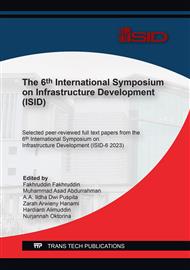p.3
p.11
p.33
p.41
p.47
p.57
p.69
p.81
Experimental Study of Cement Setting Time Using Naptha Belide E121 Admixture on 24-Hour Fast Track Concrete Quality K-500
Abstract:
Concrete innovation in terms of changing some of its properties to improve quality and workability cannot be separated from the use of chemical additives, one of the admixtures that was used in this research was a type of superplasticizer with the brand Naptha Belide E121 Series. In this research the author wanted to examine the setting time admixture of Naptha Belide E121 Series in the application of 24-hour fast-track concrete K-500, the use of admixture doses in this research was 0%, 0.4%, 0.6% 0.8%, 1.0%, 1.2%, 1.4%, 1.6%, 1.8%, 2.0%, 2.2% of the weight of cement, while the cement used was OPC Cement (ordinary Portland cement) Type 1. This research aimed to determine the cement setting time in K-500 high-quality fast-track concrete applications with dose variations. The results of the setting time test of this research were that at a dose of 0%, the initial setting time was 117.01 minutes, while 0.4% - 1.0% of the initial setting time of cement increased or slowed down starting from 178.25 minutes - 240.71 minutes. At the same time, at doses of 1.0% to 1.8% doses, the initial setting time decreased or accelerated from 165.21 minutes to 92.86 minutes.
Info:
Periodical:
Pages:
11-31
Citation:
Online since:
June 2025
Authors:
Keywords:
Price:
Сopyright:
© 2025 Trans Tech Publications Ltd. All Rights Reserved
Share:
Citation:


